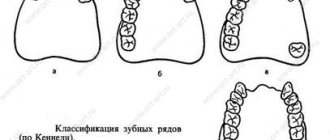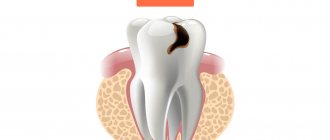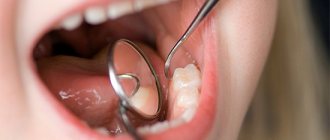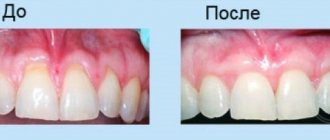What causes dental caries?
Caries is a progressive disease that destroys the hard tissues of the tooth. Cariogenic bacteria live in the oral cavity; they form a biological film on the surface of the teeth - dental plaque. They feed on carbohydrates that enter our bodies through food and drinks. Bacteria process sugars and produce organic acids. Those, in turn, corrode tooth enamel and deep tooth tissues. This is how caries develops.
In this article
- What causes dental caries?
- How does caries progress?
- A dangerous complication of caries is pulpitis.
- How is pulpitis treated?
- Periodontitis as a dangerous consequence of caries
- How is periodontitis treated?
- What is the danger of caries for the gastrointestinal tract?
- ENT diseases as consequences of caries
- Why is caries dangerous for the heart and blood vessels?
- Risk of death from dental caries
- Conclusion
Although bacteria living in the oral cavity play an important role in the development of carious lesions, a complex of unfavorable factors is important for tooth decay:
- an abundance of “fast” carbohydrates in the diet (sweets, flour);
- poor dental and oral hygiene;
- lack of calcium, fluorine, phosphorus, vitamin D in the body;
- weakened immunity.
Pain is a good signal
The connection between internal organs and teeth and the oral cavity is evidenced by medical statistics on patient treatment accumulated over many years. For example, bad teeth can be a source of headaches. Damage to molars - there is pain in the parieto-occipital region. A source of infection in the maxillary incisors can lead to pain in the frontotemporal region, and from diseased canines the pain can be concentrated in the temporal region. If you have problems with the teeth of the lower jaw, a migraine may develop, and it can only be alleviated by visiting a dentist.
Painful sensations in the upper and lower incisors are a reason to get checked for cystitis, otitis media, or treat chronic pyelonephritis. Pain in the first incisor is a possible syndrome of prostate adenoma, frontal sinusitis, tonsillitis, prostatitis, osteochondrosis. Aching pain in the fangs is possible with hepatitis or cholecystitis.
Chronic pneumonia can be diagnosed by pain in the 4th and 5th molars. The same focus of pain indicates colitis, advanced dysbacteriosis, an allergic reaction (rhinosinusitis, bronchial asthma, respiratory allergosis).
How does caries progress?
There is a myth that caries is necessarily a hole in the tooth, but in reality, dental disease begins with the loss of mineral substances in the tooth enamel and gradually progresses. Caries goes through four stages in its development. Let's look at them below.
- Spot stage.
There is no hole in the tooth yet, but a whitish spot is noticeable on the surface. A change in the color and structure of the enamel means that it is losing minerals in this area. At an early stage there is no pain or discomfort, so patients rarely go to the dentist, not even suspecting the presence of caries. But it is at the spot stage that caries is easiest to cure. The progression of the disease can be stopped using conservative methods without drilling or installing a filling. At this stage, remineralization, simple and deep fluoridation, and the infiltration method are effective.
- Superficial caries.
At this stage of development of the disease, a small carious cavity forms within the enamel. The patient may have the first complaints: the tooth reacts to cold and hot, sour and sweet, food gets stuck in the resulting hole.
- Average caries.
The carious cavity becomes larger and affects the dentin - the bone tissue of the tooth under the enamel. At this stage, acute toothache most often appears; food stuck in the hole causes severe discomfort, and the patient complains to the dentist. It will not be possible to cure average caries without preparing the tooth, so an operative approach is used in treatment - using a drill, the affected tissue is removed and the cavity is filled with special composite materials.
- Deep caries.
The carious lesion affects the deepest layers of dentin and approaches the dental nerve. All the symptoms that were there before intensify, sometimes becoming chronic. Frequent complications of deep caries are pulpitis and periodontitis (inflammation of the pulp and tissues surrounding the tooth root).
It is better to treat caries in the early stages, while there is no carious cavity in the tooth. Conservative methods will help stop the pathological process without drilling and filling. If a hole has already formed in the tooth, then you cannot do without a drill. What if you don't treat it? Many people have been afraid of dentists since childhood and put off visiting the doctor as much as possible. This should not be done under any circumstances, because caries is dangerous for the body due to its consequences. With an advanced form of the disease, you can lose a tooth or develop purulent inflammation. There are even cases of death from complications of deep caries. Therefore, it is imperative to treat the disease!
Types of caries
You can learn to distinguish caries on baby teeth by stages from a photo, or by knowing a description of external signs:
- Initial caries of baby teeth is noticeable on the enamel as a matte white spot. It is treated by strengthening the enamel with fluoride compounds, which can be quickly eliminated if detected in a timely manner.
- Surface. The spots are still light, but pain is already possible when eating.
- Average. Carious cavities become deeper - the tooth enamel is already destroyed, pain appears when cold or hot.
- Deep caries. Requires an urgent appointment with a dentist and treatment, since the infection has already reached the dentin and can spread to the pulp. If you ignore caries of baby teeth at this stage, the risk of root infection and the appearance of a baby tooth cyst increases significantly.
Dolotova Marina
Little patients of Aza&Buka rarely encounter deep caries. After all, we, doctors, do everything necessary for this - we make appointments on time, teach how to brush teeth and eat right. And if caries occurs in baby teeth, we treat it as early as possible!
A dangerous complication of caries is pulpitis.
The most common consequence of untreated caries is pulpitis. It occurs when the infection extends beyond the tooth and spreads to the pulp - the neurovascular bundle, or dental nerve.
The pulp contains nerves and blood vessels and provides nutrition to the dental tissues. Therefore, with pulpitis, the tooth may lose vitality. In severe cases, inflammation spreads to neighboring tissues.
A characteristic symptom of pulpitis is acute, prolonged pain that is difficult to tolerate. It often has a pulsating nature and can radiate to the temple, ear, or throat. The peculiarity is that attacks of pain appear at certain intervals, last about 5 minutes, and can intensify when lying down. It is necessary to begin treatment of pulpitis as quickly as possible.
How is pulpitis treated?
Pulpitis can be treated biologically or surgically. The first is applicable if the disease is in its early stages. The dentist strives to preserve the pulp by eliminating only the inflammation. If possible, pulpitis of primary teeth is treated using a biological method, when it is especially important to preserve the tooth root. Treatment is carried out in several stages. First, the dentist prepares the carious cavity, opening it as wide as possible. Then he treats it with an antiseptic, puts a swab with an antibacterial agent and covers the tooth with a bandage. During the next appointment, if the patient has no complaints, the cavity is treated with medication, filled with a special composition that stimulates dentin production, and a temporary filling is placed for a period of 5 to 7 days. During the third appointment, the dental crown is filled.
When the biological method of treating pulpitis is ineffective, surgical treatment is used. In this case, the inflamed neurovascular bundle is removed completely or partially. Without a nerve, a tooth becomes unviable and its service life is reduced.
Surgical treatment is performed with local anesthesia. First, the carious cavity is prepared, the pulp is removed, the affected area is treated with an antiseptic, medication is injected, and first the root canals are filled, and then the dental crown. As with the biological method, surgical treatment is carried out over several visits to the dentist.
If pulpitis is not treated, it will progress and can lead to very serious complications:
- flux - inflammatory process in the periosteum;
- periodontitis - inflammation of the tissues surrounding the tooth;
- pulp necrosis - death of its cells;
- sepsis is a blood infection that can develop when an infection enters the bloodstream.
You can avoid such complications if you do not delay your visit to the dentist and begin treatment for the disease at the first symptoms.
Periodontitis
The infectious process goes further along the root canals and at the exit from them it can cause periodontitis. Periodontitis is a lesion of the tissues surrounding the tooth. Acute periodontitis is characterized by severe pain and the sensation of an “overgrown tooth.” This sensation appears due to the fact that exudate forms in the peri-root space, and it puts pressure on the tooth from the inside. A fistula with purulent discharge may appear on the gum. If periodontitis is not treated, then tooth loss is not the worst development of the disease.
Periodontitis as a dangerous consequence of caries
Against the background of untreated caries and dental pulpitis, the infection penetrates even deeper. As a result, periodontitis develops. This is a disease in which the tissue around the tooth root becomes inflamed - periodontium. Essentially, it is a ligamentous apparatus that holds the tooth in the jaw and provides shock absorption. With periodontitis, an abscess may form near the diseased tooth, and in this case, treatment will require opening the tooth and cutting the gum.
Periodontitis can occur in acute and chronic forms. Acute is characterized by a rapidly developing inflammatory process. The tooth darkens, becomes loose, the patient complains of acute pain, inflammation of the cheek may occur, and swelling appears in the area of the affected tissue. In a chronic course, pronounced symptoms may be absent, and pain occurs only during periods of exacerbation. Chronic periodontitis requires long-term complex therapy, which can take several months. The disease greatly weakens the immune defense and generally negatively affects the condition of the body.
How is periodontitis treated?
The approach to treating periodontitis may vary depending on its type, severity, patient history and other factors.
The chronic form of the disease is treated according to the following scheme:
- The area of the diseased tooth is numbed with anesthetics.
- First, the affected tissue and old fillings are removed from the root canal, the tooth is depulped, and, if necessary, the root canal is expanded using dental drills or a microscopic incision.
- At the second stage, the root canal is cleaned and washed with antiseptic solutions. An antibacterial drug is placed into the canal cavity, which relieves the inflammatory process and fights infection.
- The tooth is covered with a temporary filling, and antibacterial and anti-inflammatory drugs are prescribed.
- The patient is sent home, where he must strictly follow all the dentist’s recommendations. The next appointment is usually scheduled after three or four days.
- At the second stage of treatment, a control photograph is taken. If the inflammation is stopped, the dentist removes the temporary filling and medicine from the root canals, rinses the cavities with an antiseptic, and fills the canals with a special composite material. It contains substances that help restore dental tissues and destroy pathogenic microorganisms. This filling of the canals is temporary and is needed in order to completely stop the inflammation and reduce the risk of re-developing periodontitis in the future. It is done for several months, and the tooth is again covered with a temporary filling.
- A few months later, the patient comes for a follow-up appointment with the dentist, where a tooth photograph is taken again to evaluate the effectiveness of the treatment. If the inflammation has completely stopped, the final stage of treatment begins - replacing temporary fillings with permanent ones and restoring the dental crown with a permanent light-curing filling. After this, the process of treating chronic periodontitis is considered complete.
- Unfortunately, it is not always possible to carry out conservative treatment of this disease. In advanced forms, the dentist is forced to resort to surgical treatment, when part of the root or the entire tooth is removed.
Treatment of periodontitis is long, complex and expensive, and the disease itself is a source of chronic infection, negatively affects the entire body, and weakens the immune system. It is easier and safer to contact the dentist on time and treat early caries. The consequences of an advanced disease are dangerous for the body.
When to go to an orthopedist and when to go to a surgeon
Orthopedic and orthodontic services fall into the category of “special cases”, when not just “minor repairs” are required, but normalization of the condition of the dentition (bite correction), restoration of the maxillofacial area after damage, and elimination of deformation.
You should go to an orthopedist for dental restoration or prosthetics (if there are missing teeth or severe tooth decay). The specialist will recommend a treatment plan, select crowns (made of zirconium dioxide or pressed ceramics), install veneers for those wishing to do so, or guide the patient through the thorny path to the joy of owning implants.
To straighten your teeth and correct deformities, see an orthodontist. Any orthodontist will confirm: an uneven bite can cause pathologies of the dental system. In this area of dentistry, braces or plates are selected and installed for the patient (for early loss of baby teeth) after the necessary diagnosis. By the way, you can straighten your teeth without braces.
Many people perceive tooth extraction as something fatal, and take this step only when absolutely necessary. However, sometimes you have to part with a tooth. If the doctor has identified a focus of chronic infection (or several lesions), be prepared that you will be offered to eliminate it. This will help prevent bacterial growth, which can damage internal organs.
For those who are experiencing tooth loss, good news: modern dentistry offers express dental implantation.
The one-stage implantation technique is used by surgeons at the Dr. Martin clinic when the patient is partially or completely missing teeth, the dental roots are injured, or the crown part of the tooth is damaged. You should ask your doctor about contraindications immediately before the procedure.
Doctors use the products - a long-time partner of the clinic, which provides dentistry with dental implants and consumables under special conditions. The clinics also have their own trading house and dental laboratory. This means that dentistry does not have intermediaries in the form of third-party organizations, so it is possible to offer optimal prices.
What is the danger of caries for the gastrointestinal tract?
Caries and its complications have a harmful effect not only on teeth, but also on other organs and systems of the body. In particular, diseases of the gastrointestinal tract - pancreatitis, gastritis, duodenal and stomach ulcers - often occur against the background of dental caries.
The fact is that with caries and any other dental diseases, pathogenic microflora is activated in the oral cavity. Together with food and saliva, it can easily penetrate the esophagus into the stomach and intestines, causing an inflammatory process. As microbes multiply, they crowd out beneficial microorganisms and lead to the development of gastrointestinal diseases. On the other hand, the state of the digestive organs directly depends on the quality of chewing food. Caries negatively affects this function, because with damaged chewing teeth a person cannot efficiently process food to such a state that the gastrointestinal tract can easily absorb and digest it. As a result, there is an excess load on the stomach, intestines, and duodenum, which leads to pathologies of the digestive organs. In addition, poorly chewed food makes it worse for nutrients to be absorbed.
Modern research shows that even deposits on healthy teeth can threaten the health of the stomach and intestines. Thus, the bacteria Helicobacter pylori accumulate in tartar, which contributes to the development of peptic ulcers. Therefore, not only timely treatment of caries, but also its prevention, in particular proper and regular oral hygiene, helps reduce the risk of gastrointestinal diseases.
What happens if childhood caries is not treated?
Treatment of caries of primary teeth, as well as prevention of dental diseases are very important.
And waiting for your teeth to change is wrong and unreasonable. Arguments in favor of monitoring children's health and timely treatment will be:
- High probability of infection of permanent units. Under the milk teeth are the rudiments of the molars. Untreated caries can easily spread to permanent teeth and cause more serious problems.
- Early removal of milk units. In children, caries spreads quickly, and if the crown is severely damaged, doctors remove the tooth. But if the molar is not yet ready to grow, the incisors, canines and molars in the mouth begin to shift. The child’s bite deteriorates, which then has to be corrected with braces, aligners or other orthodontic systems.
- Serious problems with diction. Extracted and damaged teeth make it difficult to clearly pronounce sounds, which complicates communication with peers and often negatively affects school performance.
- Vulnerability to infections. A bad tooth threatens not only the dental health of neighboring units, but can also cause frequent throat diseases and provoke problems with the gastrointestinal tract and heart.
- The appearance of complexes. Decayed teeth look unsightly, which is why the child smiles less and grows aloof and uncommunicative.
- Delayed bite change. After suffering from pulpitis or periodontitis, the resorption of the roots of temporary teeth often stops. This means that baby teeth stop falling out on their own, and they have to be removed by a surgeon.
It is also worth remembering that the process of updating the bite is extended over time and can take up to 6-8 years. Does a child really have to suffer with bad teeth all this time?
Rodikova Tatyana
Unfortunately, parents still have to be convinced to treat caries of baby teeth in children. Many people do not see the danger in this disease and believe that the problem will disappear in the process of changing teeth. After explaining the harm of a carious infection in the oral cavity, many, however, agree with the doctor’s opinion. And every such case makes me very happy!
Why is caries dangerous for the heart and blood vessels?
When brushing your teeth, there is a risk of injury to your gums. This can happen due to a brush that is too hard, careless use of dental floss, or sensitivity of the gums themselves. One way or another, cariogenic bacteria enter the resulting wounds, which can be carried throughout the body by the bloodstream. If they get into the tissue of the heart, inflammation of its valves may develop - infective endocarditis.
Studies show that with advanced caries, the risk of developing cardiovascular pathologies increases by 70%. When bacteria enter the blood, they settle on the vascular walls next to atherosclerotic plaques. As a result, the plaque begins to actively grow and can clog the vessel, disrupting normal blood flow. The most dangerous consequences can be thrombosis, stroke, heart attack, atherosclerosis.
Risk of death from dental caries
Many people underestimate the danger of caries, considering this disease to be frivolous. However, there are known cases of death from complications of untreated caries. How is this possible?
For example, if the inflammatory process from the roots of the teeth of the upper jaw spreads to the maxillary sinuses, sinusitis may occur, which can spread greatly without treatment. When the infection extends beyond the jaws, there is a possibility of a brain abscess, purulent inflammation, sepsis - all these complications can be fatal.
Another danger is the so-called pathological fracture of the jaw. This condition is associated with a cyst in the jaw, which occurs as a complication of advanced caries.
All of these dangers are real and can occur against the background of dental caries. But it is important to understand: only an advanced carious process that has not been treated for many months or even years leads to such serious complications. With regular visits to the dentist, timely treatment of caries at the first symptoms, as well as compliance with the rules of dental hygiene and other preventive measures, the risk of serious consequences for the body is almost zero.
Is it possible to cure a complex case or is it better to remove the diseased tooth?
Is it possible to cure a complex case or is it better to remove the diseased tooth?
Did you know that the patient and the dentist sometimes have different opinions about a complex case?! For example, patient Z has a tooth that is almost half destroyed, and the doctor, after carefully studying the picture, suggests treating the canals and making an inlay - to spend another 10 years with this teeth. Here’s another example: the front lower teeth are quite intact, and they haven’t even changed color, but caries has become noticeable between the teeth - patient Q thinks that it’s not scary and therefore was in no hurry to see the dentist, and the doctor, after looking at the picture, said that it was a case complex and treatment will not be easy! Most likely, a cyst or granuloma has appeared in the hilar area, the size of which still allows therapeutic treatment to begin and resection to be avoided.
Granuloma or cyst are pathological diseases of the tooth that attack the tooth and destroy bone tissue in the root area. A cyst or granuloma is a pathological cavity with dense walls filled with bacteria and dead cells. Such a bubble grows slowly but surely, destroying the bone tissue under the tooth and its neighbors, which is why a dental cyst is called a time bomb.
How is a cyst different from a granuloma and why are they bad?
The differences are primarily in the size of the bubble, which is lodged at the top of the tooth root. The granuloma has a diameter of no more than 0.8 cm, and the cyst - from 0.8 - 1.2 cm. The formation and growth of the granuloma is most often asymptomatic; in rare cases, the cyst can react with acute pain to stress, hypothermia or other external factors. Having reached its maximum, the granuloma transforms into a cyst and begins its main task of “melting” the bone tissue around itself. The cyst does not spare the human body, it hurts throughout the body, causing chronic fatigue, severe headaches, fever, inflammation of the lymph nodes, etc. The causes of dental granuloma are classic dental diagnoses, that is, granuloma is provoked by pulpitis or periodontitis, but granuloma can also appear as a result of tooth trauma (broken, chipped, cracked) and, in the end, there are cases of improper tooth treatment, that is, non-compliance with septic rules and asepsis during root canal treatment. The causes of cysts are similar to granulomas, so advanced caries or pulpitis provoke a granuloma and, as a result, a cyst, as well as tooth trauma, prosthetics with an incorrectly distributed load, infections of the oral cavity and nasopharynx, pathologies of the development of the upper and lower jaws.
How are granulomas and cysts treated? Is it possible to avoid removing a diseased tooth?
These pathologies are treated in two ways - surgically and endocanally, that is, therapeutically. First of all, the dentist will offer the patient therapeutic treatment for granulomas and cysts, if the lesion requiring treatment is not subject to urgent surgical intervention. Today, dentists have modern drugs that kill the pathogenic environment inside the formed cyst, and the human immune system starts the restoration process if we help it overcome the formation. Treatment for a cyst is a long process during which you will meet with your doctor systematically over several months. The doctor must reach the cyst through the canals of the tooth and apply the medicine directly to the top of the tooth root, and then clean the canals once a month or every two weeks, add special medications that will help your body gradually “kill” the cyst, and painstakingly clean the canals every time - that is, “to take cyst tissue through the channels.”
Is it possible to cure granuloma and cyst forever?
This pathology is amenable to modern treatment; the cyst can indeed be cured or removed from the bone tissue using various methods. Dentists resort to surgical techniques in extreme cases, trying to preserve both the tooth and all its roots. If the human body is predisposed to cystic growths, then perhaps the cyst will appear again, but in a slightly different place. The main task of the patient is to monitor his health and systematically contact the dentist.
Surgical treatment of granulomas and cysts is a last resort measure taken by a dentist if the pathology has reached a very large size and interferes with a person’s normal lifestyle. Today, there are several surgical solutions that are used to remove cysts from the oral cavity:
- Cystotomy is a technique used for large formations.
- Hemisexy is an outdated method that is still applicable in some dentistry. The cyst is surgically removed along with part of the tooth root.
- Cystectomy is a surgical procedure under a microscope, considered minimally invasive and the most popular.
Revision, sometimes we make multiple visits to the dentist for the treatment of a cyst or granuloma, where repeated endodontics is a systematic and main type of treatment. If we omit the topic of cystic formation in the root region of the tooth, then re-treatment of the canals is indicated when:
- Primary treatment did not produce results, or the result was negative.
- Correction of defects of previous treatment that resulted in problems: poorly filled sections of canals, dissolved intra-root filling material, broken instruments left in the tooth.
- Indications for long-term treatment, and a tooth with a temporary filling.
Canal treatment (endodontics) is contraindicated if it is impossible to restore the coronal part of the tooth, if it is impossible to provide high-quality treatment of the wisdom tooth canals or with limited mouth opening, if there is a vertical fracture of the tooth root, severe periodontal damage to the tooth, exacerbation of general somatic diseases not related to the oral cavity .
Our dear patients, if you have been diagnosed with “Formation of a cyst or granuloma” and have been prescribed surgical treatment, we recommend that you visit two more specialists in different clinics to be sure of this treatment option. Surgery is a painful decision that requires a long recovery process. Come for a consultation with an endodontist at Family Stom Dentistry, our doctor treats very complex cases and does his work extremely meticulously under a microscope.











